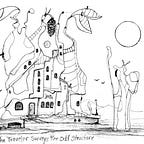How Strong Towns Principles Relate to Sioux Falls — Neighborhood Renewal
- based on “Strong Towns — A Bottom-Up Revolution To Rebuild American Prosperity” by Charles L. Marohn, Jr.
“The incremental approach to building neighborhoods contains a natural rejuvenation mechanism, introducing a third variable to the otherwise depressing menu of stagnation and decline: renewal. Traditional development drives renewal by improving the underlying value of land.”
— Chuck Marohn
Incremental development involves adding new commercial or residential buildings to neighborhoods as warranted by needs and economic activity. As buildings are added the value of the land in the neighborhood goes up. As land values increase the the value of buildings on the land may not keep up. For instance, a building in a commercial area with increasing land values may become run down or may just be too small. The increased land value makes replacing or upgrading the building economically feasible. Upgrading the building in turn may raise the land values in the neighborhood. This cyclical decline followed by redevelopment pattern is what gives the incremental development model its strength. Redevelopment may be done without requiring extensive new infrastructure and can take advantage of existing economic and social activities and services.
The value of improvements (buildings and other structures) divided by the value of the land helps determine when it is feasible to redevelop a property. For example, let’s compare two identical lots valued at $30,000 each. If one has a small structure on it that is valued at $60,000 the improvement to land ratio is $60,000/$30,000 = 2. If the other lot has a house valued at $150,000 on it the ratio is $150,000/$30,000 = 5. This calculation shows that the lot with an improvement/land ratio of 2 is a better candidate for upgrading than the one with a ratio of 5. Upgrading the $150,000 house significantly could price it “out of its neighborhood” by making it more expensive than other houses in the neighborhood. The owner might not be able to sell it for what was invested in it. The owner of the lot with a ratio of 2 , on the other hand, could probably upgrade the house significantly and still recover the investment when it is sold. So, the lower the improvement/land ratio the better the prospects for redeveloping the property.
The owner of the lot with a ratio of 2 can also benefit from rising property values by upgrading the property to include a rental unit of some kind. The rental price of the unit would reflect the property values of the neighborhood. As the neighborhood becomes more desirable rental values would rise. The property owner could benefit from the value of the neighborhood he or she helped create without having to sell and move to another neighborhood. This concept is one of the reasons cities like Minneapolis have eliminated single-family dwelling requirements. Those requirements meant that homeowners could not upgrade their property to include rental units. Eliminating those restrictions creates financial equality for neighborhoods that could not benefit from rising property values and provides needed housing. The State of Nebraska is considering legislation to eliminate single-family home requirements state-wide.
Obviously, there is concern from property owners in single-family neighborhoods over what would happen to the neighborhood if rental units are allowed. The older areas of Sioux Falls have allowed duplexes and other multiple-family buildings from the beginning. Duplexes are common in the All Saints and McKennan Park neighborhoods. A number of home remodeling projects in that area feature the addition of second-floor rental units with outside stairs. One project on Phillips Avenue includes a house on a corner lot. The older structure faces Phillips and a new addition on the side street has another rental unit and a two-car garage. It fits into the neighborhood and provides needed housing in that area. Developments of this type must honor the character of the neighborhood to keep the elements that made the neighborhood valuable in the first place. Bad redevelopments can happen (remember the McMansion along McKennan Park?) but changes to zoning laws such as form-based zoning can help prevent inappropriate development by matching building size and style to existing buildings in the neighborhood.
Growth, stagnation and renewal happen in complex neighborhoods. This allows the neighborhood to evolve and adapt to change. If we want to have resilient, economically viable cities we need to embrace the incremental development and neighborhood renewal model.
